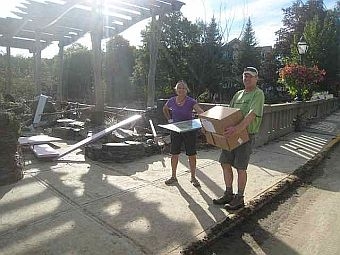 The arrival of spring in flood-damaged areas revealed a landscape that’s still raw, and in many places under construction or permanently changed by Tropical Storm Irene. Recovery workers see signs of stress on the human landscape as well, with many people’s lives and emotions still unsettled. To help sort things out, some communities have been hosting story circles –gatherings where people share their flood stories.
The arrival of spring in flood-damaged areas revealed a landscape that’s still raw, and in many places under construction or permanently changed by Tropical Storm Irene. Recovery workers see signs of stress on the human landscape as well, with many people’s lives and emotions still unsettled. To help sort things out, some communities have been hosting story circles –gatherings where people share their flood stories.
Sitting in a circle at the local high school with some neighbors and a tape recorder, Ann Coleman shares her flood story. Coleman’s art gallery on Main Street in Wilmington was swept away in the deluge. But she didn’t know that when she and her husband set out from their house in Whitingham after the storm to survey the damage.
At the outskirts of Wilmington they were told they couldn’t get into town.
"We got to the second blockade," Coleman recalls, "and they said, ‘Prepare yourselves, because it’s not good.’"
Unable to pass, Coleman grabbed her camera.
"I took a photo looking straight into town, and then I took a photo over towards the pergola. And then with my eyes, I looked back straight into town. And where my husband had just… finished the first coat of paint on our newly renovated yellow building, there was no yellow building. "
Coleman’s voice falters and she passes the microphone to the next person in the circle.
The mic belongs to the Vermont Folklife Center. The Middlebury-based non-profit specializes in oral histories. It’s been asked by many communities and groups for help collecting and preserving flood stories.
Folklife Center ethnographer Greg Sharrow, who’s here tonight, says future generations will benefit from these eyewitness accounts.
"But I also feel that there’s great value in speaking about what happened," Sharrow says, "And speaking about what happened in the company of neighbors and fellows citizens and being heard."
Starting Over Strong Vermont, the organizer of tonight’s event, has been using story circles to help survivors process the emotions associated with a disaster.
The next person to take the microphone wasn’t anywhere near the flood. Shelley Park and her family were in New Zealand for a year. They followed the disaster on Facebook.
When Park got back, people didn’t seem overly eager to discuss the August 28 disaster.
"But eventually we would talk about the flood," says Park. "And within ten minutes I’d say, most people would start crying. And most people would say, ‘Oh! I didn’t know I still felt this way.’ So even though when I got back there was a coat of snow, I feel like it’s still really palpable in the people."
The first floor of Bettina Krampetz’s house had to be gutted and rebuilt. But she was able to collect some insurance. She says her home is better than ever now.
Krampetz says the kindnesses she experienced more than compensate for the losses. She’s been waiting for this chance to express her feelings.
"I’ve just been so full of gratitude from the get-go," she says. "I had such a sense of community in the real old fashioned use of that word."
Ann Coleman, who was not insured, says she never had so many hugs or so much support as she’s had since the flood. But she’s still struggling to raise the money to rebuild her gallery.
"There are over 40 businesses affected," Coleman says. "I counted something like 14 that still have not come back. So there’s quite a long road to go."
After the circle ends, Coleman says she learned a lot from listening to her neighbors’ stories. She also learned some things from listening to herself.
She says she was surprised that so much pain emerged as she recalled that day.
Coleman says it’s satisfying to know her story has been recorded and will take its place in history. The Vermont Folklife Center will keep the recording in its permanent archive — and also provide copies to participants and local groups working on their own histories of Irene.